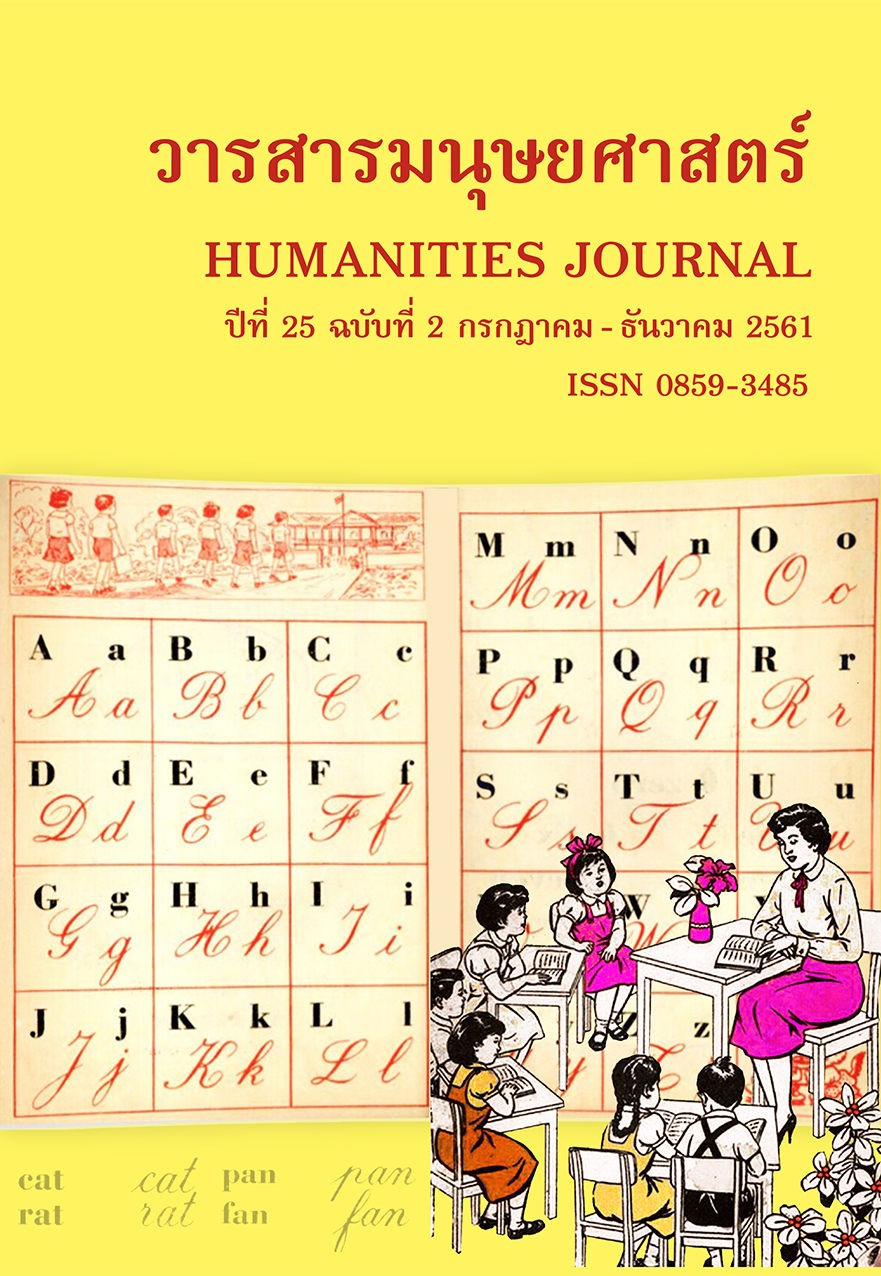The Use of Modal Devices for Volition (Intention) and Prediction in “The Lord of the Rings” Looking inside the Mind of J. R. R. Tolkien through the Main Protagonist, “Frodo”
Main Article Content
Abstract
This study attempts to analyze modal devices used by Tolkien through the main protagonist, Frodo Baggins, in the novel The Lord of the Rings to reveal how modal devices reflect Frodo’s psychological changes in the course of the story. It is believed that the character, “Frodo”, was created in the traumatically driven mind of the author himself, who suffered from his experiences in World Wars I and II (Manners, 2006). Modality is the semantic notion that covers a broad range of semantic senses expressed by the speaker, including the notion of volition (intention) and prediction. These modal senses can be expressed through the use of modal devices (Bybee & Fleischman, 1995; Frawley, 2005). The author’s use of modal devices allows him to express himself through the main protagonist’s speeches and thoughts. Thus, Frodo’s psychological changes as the story progresses can be observed through the author’s use of modal devices. The theoretical framework used in this study was adapted from Quirk’s grammatical framework of modal auxiliaries (1985) and Halliday and Matthiessen’s semi-modal systems (2014). The comparative results of modal usage from the beginning to the end of the story were created using the frequency of modal devices. It was found that the use of volition can reveal Frodo’s inner determination, while the use of prediction shows a part of Frodo’s anxiety.
Article Details
References
Bloom, H. (2008). Bloom’s Modern Critical Interpretations: J. R. R. Tolkien’s The Lord of the Rings New Edition. New York: Infobase Publishing.
Bybee, L. J. & Fleischman, S. (1995). Modality in Grammar and Discourse. Philadelphia: John Benjamins.
Coates, J. (2003). The role of epistemic modality in women’s talk. In Facchinetti, R., Krug, M. and F. Palmer (Eds.), Modality in Contemporary English (pp. 331-345). Berlin: Mouton de Gruyter.
Drout, M. D. C. (2004). Tolkien’s Prose Style and its Literary and Rhetorical Effects. Tolkien Studies, 1, 137-163.
Drout, M. D. C. & Wynne, H. (2000). Tom Shippey’s J. R. R. Tolkien: Author of the Century and a Look Back at Tolkien Criticism Since 1982. Envoi, 9(2), 101-167.
Frawley, W. (2005). The Expression of Modality. Berlin: Mouton de Gruyter.
Gotti, M. (2003). Shall and will in contemporary English: A comparison with past uses. In Facchinetti, R., Krug, M. and F. Palmer (Eds.), Modality in Contemporary English (pp. 267-300). Berlin: Mouton de Gruyter.
Halliday, M. A. K. (2014). Halliday’s Introduction to Functional Grammar (4th rev. ed.). M. I. M. C. Matthiessen (Ed.). New York: Routledge.
Jenkyns, R. (2002, Jan 2). Bored of the Rings. The New Republic. Retrieved from https://newrepublic.com/article/66085/bored-the-rings.
Krug, M. (2000). Emerging English Modals: A Corpus-Based Study of Grammaticalization (Topics in English Linguistics, No 32). Berlin: Mouton de Gruyter.
Lee, S. D. (2014). A Companion to J.R.R. Tolkien. West Sussex: Wiley-Blackwell.
Leech, G. (2004). Meaning and the English verb (3rd ed.). New York: Routledge.
Leech, G. & Short, M. (2007). Style in Fiction: A Linguistic Introduction to English Fictional Prose Second edition. Great Britain: Pearson.
Leon, E. (2001). An Exploration of Modality in H. Pinter's The Dumb Waiter. CAUCE 24, 259-268.
Manners, P. J. (2006). Frodo’s journey. The Psychologist, 19(2), 98-99.
Parina, J. C. N. & Leon, K. D. D. (2014). A Stylistic Analysis of the Use of Modality to Identify the Point of View in a Short Story. 3L: The Southeast Asian Journal of English Language Studies, 20(2), 91-100.
Pope, R. (2002). The English Studies Book: An introduction to language, literature and culture (2nd ed.). London: Routledge.
Quirk, R., Greenbaum, S., Leech, G. & Svartvik, J. (1985). A Comprehensive Grammar of the English Language. New York: Longman.
Reid, R. A. (2009). Mythology and History: A Stylistic Analysis of The Lord of the Rings. Style, 43(4), 517-538.
Shippey, T. (2002). J.R.R. Tolkien: Author of the Century. New York: Mariner Books.
Shippey, T. (2003). The Road to Middle-Earth: How J.R.R. Tolkien Created a New Mythology. New York: Mariner Books.
Simpson, P. (1993). Language, Ideology and Point of View. London: Routledge.
Tolkien, C. (2000). The Letters of J.R.R. Tolkien. H. Carpenter (Ed.). London: HarperCollins.
Wagner, V. (2007). Tolkien proves he's still the king. In Toronto Star (Online). https://www.thestar.com/entertainment/2007/04/16/tolkien_proves_hes_still_the_king.html, April 7, 2015.
Weiner, E. S. C. & Delahunty, A. (1995). The Oxford Guide to English Usage (2nd ed.). Oxford: Oxford University Press.
Willbern, D. (2013). The American Popular Novel After World War II: A Study of 25 Best Sellers 1947-2000. North Carolina: McFarland.
Wilson, E. (1956). The Bit between My Teeth: A Literary Chronicle of 1950-1965. New York: Farrar.


